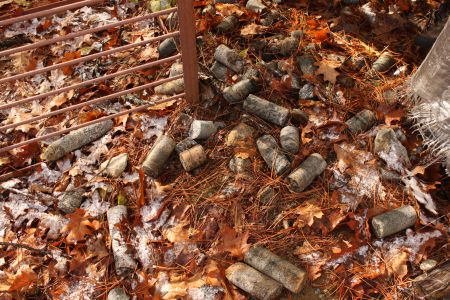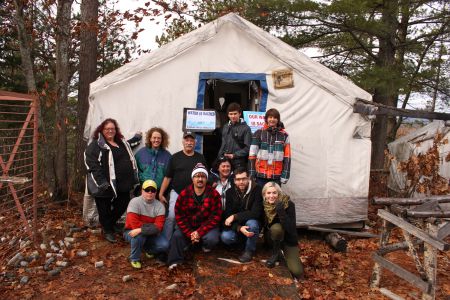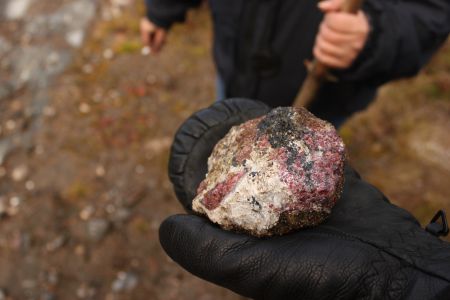MONTREAL—“Eco-consciousness” and “green living” are centrepieces of product branding for the Toyota Prius. But that feel-good packaging has rapidly worn thin for members of the Algonquin Nation and residents of Kipawa, Quebec, who are now fighting to protect traditional Algonquin territory from devastation in the name of hybrid car battery production.
In 2011, after nearly two years of negotiations, Matamec Explorations, a Quebec-based junior mining exploration company, signed a Memorandum of Understanding with Toyotsu Rare Earth Canada (TRECan), a Canadian subsidiary of Japan-based Toyota Tsusho Corporation. The memorandum confirmed Matamec’s intention to become “one of the first heavy rare earths producers outside of China.” In pursuit of this role, the company plans to build an open-pit Heavy Rare Earth Elements (HREE) mine directly next to Kipawa Lake, the geographical, ecological, and cultural centre of Kipawa.
Rare earths are a group of 17 elements found in the earth’s crust. They are used to produce electronics for cell phones, wind turbines, and car batteries. Rare earths are notorious for their environmentally costly extraction process, with over 90 per cent of the mined raw materials classified as waste.
Toyota has guaranteed purchase of 100 per cent of rare earths extracted from the proposed Kipawa mine, for use in their hybrid car batteries, replacing a portion of Toyota’s supply currently sourced out of China.
Over the last seven years, China has reduced the scale of its rare earths exports via a series of annual tonnage export caps and taxes, allegedly out of concern for high cancer rates, contaminated water supply, and significant environmental degradation. Despite China’s stated intention to encourage manufacturers to reduce their rare earths consumption, the US, the EU and Japan have challenged China’s export caps through the World Trade Organization (WTO) and are seeking new deposits elsewhere for exploitation. Toyota and Matamec are seeking to make Kipawa part of this shift.
Kipawa is a municipality located on traditional Algonquin territory approximately 80 kilometres northeast of North Bay, Ontario, in what is now known as western Quebec. The primarily Indigenous municipality is home to approximately 500 people, including members of Eagle Village First Nation and Wolf Lake First Nation, of the Anishinaabeg Algonquin Nation. The town of Kipawa lies within the large Ottawa River Watershed, a wide-branching network of lakes, rivers and wetlands. Lake Kipawa is at the heart of the Kipawa region.
Lifelong Kipawa resident and Eagle Village First Nation member Jamie Lee McKenzie told The Dominion that the lake is of “huge” importance to the people of Kipawa. “We drink it, for one....Everyone has camps on the lake [and] we use it on basically a daily basis.” This water network nourishes the richly forested surroundings that make up the traditional hunting and trapping grounds of the local Algonquin peoples.
“Where the proposed mine site is, it’s my husband’s [ancestral] trapping grounds,” said Eagle Village organizer Mary McKenzie, in a phone interview with The Dominion. “This is where we hunt, we fish, I pick berries....We just want to keep our water.” Jamie Lee and Mary McKenzie also emphasized the role of lake-based tourism in Kipawa’s economy.
The Kipawa HREE project would blast out an open-pit mine 1.5 kilometres wide and 110 meters deep, from the summit of a large lakeside hill. It would also establish a nearby waste dump with a 13.3 megatonne capacity. Rock containing the heavy rare earth elements dysprosium and terbium would be extracted from the pit via drilling and explosives, processed at an on-site grinding and magnetic separation plant, and then transported by truck to a hydrometallurgical facility 50 kilometers away for refining.
Matamec confirmed in its Preliminary Economic Assessment Study that some effluence caused by evaporation and precipitation is inevitable, especially during the snowmelt period. A community-led presentation argued that this could create acid mine drainage, acidifying the lake and poisoning the fish.
“There’s going to be five [truckloads of sulfuric acid transported from pit to refinery] a day....[I]n a 15-year span, that’s 27,300 truckloads of sulfuric acid,” said Mary McKenzie. “We’re worried about spills and the environment....They’re talking about neutralizing [the acid], when a spill does occur, with lime. I have [sources that say] lime is also a danger to the environment.”
In a 2013 presentation in Kipawa, Matamec stated that while “some radioactivity [due to the presence of uranium and thorium in waste rock] will be present in the rare earth processing chain,” its effects will be negligible. Yet these reassurances ring hollow for some, who point to cancer spikes observed in communities near rare earths projects in China. In the project’s economic assessment, Matamec itself indicated that waste rock is too dangerous for use in concrete and dikes.
“Whatever goes up in the air [from blasting and evaporation] comes down....A lot of those particles are radioactive,” said Mary McKenzie. “Our animals eat this [plant matter potentially affected by the mine]....We depend on our moose, we depend on our fish, so that’s a scary situation.” The refining process also uses strong acids and bases.
While Matamec stated in the Assessment that “most” of the water used in processing will be recycled, a portion of the post-processing solution will be directed into the lake or tailings ponds. The mine is intended to be operational for 13 years, but tailings ponds would require maintenance for generations, and leaching is always possible. Adding to this risk, Matamec has “assumed that [certain] tailings will not be acid generating or leachable” and will therefore only use watertight geomembrane for a portion of the tailings ponds.
With the approval process being accelerated by both public and private factors, production could begin as early as 2015. Quebec’s regulations call for provincial environmental impact assessments only when projects have a daily metal ore production capacity that is considerably higher than the national standard—7,000 metric tons per day versus 3,000 in the Canadian Environmental Assessment Act. What’s more, by categorizing HREE in the same regulatory group as other metals, these tonnage minimums fail to reflect the higher toxicity and environmental costs of heavy rare earths extraction.
Because of this, the Kipawa project does not trigger a provincial-level assessment. It only requires clearance from the Canadian Environmental Assessment Agency and a certificate of authorization granted by the provincial Minister of Sustainable Development, Environment and Parks.
On the private side, the assessment process has been fast-tracked by a series of multimillion-dollar payments from TRECan to Matamec ($16M as of April 2013). According to Matamec president André Gauthier in a July 2012 press release, this makes Matamec “the only rare earth exploration company to have received funds to accelerate and complete a feasibility study and an environmental and social impact assessment study of a HREE deposit.”
The chiefs of Eagle Village and Wolf Lake First Nations have been demanding a consent-based consultation and review process since the project was quietly made public in 2011—one that exceeds “stakeholder” consultation standards and acknowledges the traditional relationship of the Algonquin people to the land. Residents only became widely aware of Matamec’s plans following the company’s community consultation session in April 2013.
Jamie Lee McKenzie has not been impressed by Matamec’s consultations. “They come in and they have a meeting...and they tell us all the good things about the mine,” McKenzie told The Dominion. “[They say,] ‘It will give you jobs. We need this to make batteries for green living,’ but that’s it.”
Local organizers told The Dominion that a Matamec-chaired community focus group had been cancelled during the early summer after one local participant asked that her critical questions be included in the group’s minutes. Following what many residents see as the failure of Matamec and provincial assessment agencies to meaningfully engage with Kipawa residents, the community has taken matters into their own hands.
In the summer of 2013, Kipawa residents began to organize, with the leadership of Eagle Village and Wolf Lake members. Petitions containing over 2,500 signatures were sent to provincial ministers, demanding a provincial environmental assessment as well as “public hearings to review the Mining Act...to strengthen rare earth environmental monitoring.” As of late November, there had been no official responses to the petitions, and no positive response to letter-writing campaigns directed at the office of the federal Minister of Environment. (Quebec adopted a new Mining Act in early December, as this article went to print.)
But demands have grown beyond calls for review. “We’re not okay with the BAPE [provincial assessment]; we’re not okay with the mine,” said Mary McKenzie. “We’re against the [project] 100 per cent.” In September, McKenzie helped organize a 100-person anti-mine protest on the shores of Kipawa Lake. In November, the resistance network formalized their association as the Lake Kipawa Protection Society, committed to stopping the mine through regional education, local solidarity, and creative resistance strategies like a “Tarnish Toyota” day of action.
The Kipawa HREE project, if approved, would open doors for the numerous other companies exploring the watershed—such as Globex, Fieldex, Aurizon, and Hinterland Metals—as well as for heavy rare earths mining in the rest of Canada.
“We have mining companies all over in our area here,” said Mary McKenzie. “Matamec is the most advanced, but it’s not just Matamec: we want all the mining out of our region.”
The mine is not the only project on the fast-track: Algonquin and local resistance efforts are picking up momentum, and backing down on protecting the water and land is not on the agenda.
“This is ancestral ground,” McKenzie stressed. “We can fight this.”
Claire Stewart-Kanigan is a student, Settler, and visitor on Haudenosaunee territory.





